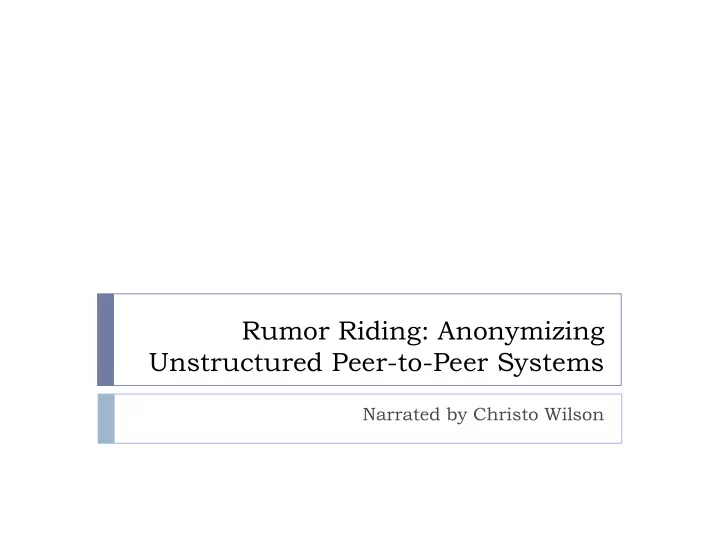

Rumor Riding: Anonymizing Unstructured Peer-to-Peer Systems Narrated by Christo Wilson
Table of Contents Table of Contents � Problem Scenario � Existing Anonymity Schemes � Existing Anonymity Schemes � T or � Crowds � Rumor Riding � Design Goals � Protocol Design � Example � Analysis � Analysis � Practical Considerations � Conclusions � Conclusions
Problem Scenario Problem Scenario � You want a copy of that new Justin Timberlake song � T � T oo embarrassed to get it from a store oo embarrassed to get it from a store � RIAA fueled by devouring human souls � What is needed: Anonymization y � Existing protocols are unsuitable for P2P � Path-based � H � Heavyweight, asymmetric layered encryption i ht t i l d ti � Proposed solution: Rumor Riding � Non-path based (sort of) � Non path based (sort of) � Uses Symmetric encryption (mostly)
Existing Schemes: Existing Schemes: Onion Routers ? Initiator Responder P2P Network
Existing Schemes: Existing Schemes: � Why not use Tor for P2P? � Designed for client-server architectures � Designed for client server architectures � No responder anonymity by default � Could be re-architected to fix this deficiency � Asymmetric decryption at every hop � Key exchange nightmare � Pathing: � Pathing: � Construction requires knowledge of many peers � Must be persistent for duration of file transfer � Paths must be explicitly rebuilt periodically to maintain anonymity
Existing Schemes: Crowds Existing Schemes: Crowds Jondos ? Initiator Responder P2P Network
Existing Schemes: Crowds Existing Schemes: Crowds � Why not use Crowds for P2P? � As with T � As with T or designed for client-server architectures or, designed for client server architectures � No responder anonymity by default � Could be re-architected to fix this deficiency � Symmetric decryption at every hop provides weaker anonymity � Still have a key exchange nightmare � Still have a key exchange nightmare � Pathing: � Must be persistent for duration of file transfer � Lack of source-routing provides weaker anonymity
Rumor Riding: Design Goals Rumor Riding: Design Goals � Provide high degree of initiator and responder anonymity � Use symmetric encryption � Use symmetric encryption � Do not require extensive key exchanges � Design with attributes of P2P topology in mind: � Design with attributes of P2P topology in mind: � Do not require any explicit path construction � Require as little path-persistence as possible
Rumor Riding: Protocol Design Rumor Riding: Protocol Design � Every message split into two pieces: encrypted data and key � Symmetric encryption (AES, 128-bit) � Each piece called a rumor � Data and key each forwarded to different neighbors � D t d k h f d d t diff t i hb � Rumors continue travelling outward in a random walk � Nodes maintain rumor caches � Rumors constantly checked for pairings (collisions) � Collisions identified using CRC check � Nodes which identify rumor collisions become sowers N d hi h id if lli i b � Act as the proxy for the initiator
Rumor Riding: Protocol Design Rumor Riding: Protocol Design � Conversations encrypted with public keys � Initial query and response include initiator and responders keys � Initial query and response include initiator and responders keys � 1024-bit RSA prevents eavesdropping on conversations � Rumor convergence is controlled g � Rumors can be issued in multiples � Each rumor has an adjustable TTL
Rumor Riding: Example Rumor Riding: Example ? Potential Sowers ? P2P N P2P Network k Initiator Potential Sowers Potential Sowers Responder
Rumor Riding: Analysis Rumor Riding: Analysis � Resilient to attack � Forwarding provides Crowds-like plausible deniability � Forwarding provides Crowds like plausible deniability � Separating paired rumors makes local eavesdropping difficult � End-to-end public key encryption prevents man-in-the-middle attacks � Random walks prevent timing attacks and traffic analysis
Rumor Riding: Analysis Rumor Riding: Analysis Potential Sowers P2P N P2P Network k Initiator Potential Sowers Potential Sowers Responder
Rumor Riding: Analysis Rumor Riding: Analysis � Trace driven simulation � 1 000 to 100 000 node Gnutella-like network � 1,000 to 100,000 node Gnutella like network � 600 second mean node lifetime � Theoretical vs. Simulated rumor collision rates:
Practical Considerations Practical Considerations � O(n) processing overhead � Every incoming rumor must be decrypted and CRCed against entire cache contents � Static RSA key pairs enables correlative attacks � Compromised initiators and/or responders can track remote hosts p p individually, uniquely � Duplication of effort, non-unique search query results � Queries are usually controlled floods � Queries are usually controlled floods � K-Rumors can result in K sowers issuing queries � Each query may elicit identical responses � File chunking necessitates return path persistence or constant Fil h ki i h i production of new rumors � Payload rumors in multiple may result in duplicates at receiver
Practical Considerations Practical Considerations � Small-world networks significantly compromise anonymity � Compromised super-nodes can potentially allow statistical � Compromised super nodes can potentially allow statistical ascertain of initiators/responders � Rumor collision distance inversely related to collision rate
Practical Considerations Practical Considerations � Latency � Numbers are way higher � Numbers are way higher than cumulative latencies for path-based protocols � This applies to file transfers Thi li fil f too, not just queries!
Conclusions Conclusions � Novel protocol design � Surprising that any random walk based protocol even works p g y p � Decent anonymity � Integrates well with P2P network topologies � Trace driven simulations help prove feasibility � T d i i l ti h l f ibilit � Promises of low overhead and no-pathing are overblown � High latency and rumor generation overhead may hinder � High latency and rumor generation overhead may hinder large file transfers � Seems geared toward Gnutella-like P2P protocols � Would be more useful/applicable if it worked for T orrents
Questions? Questions? � No, I don’t have any Justin Timberlake for you.
Recommend
More recommend